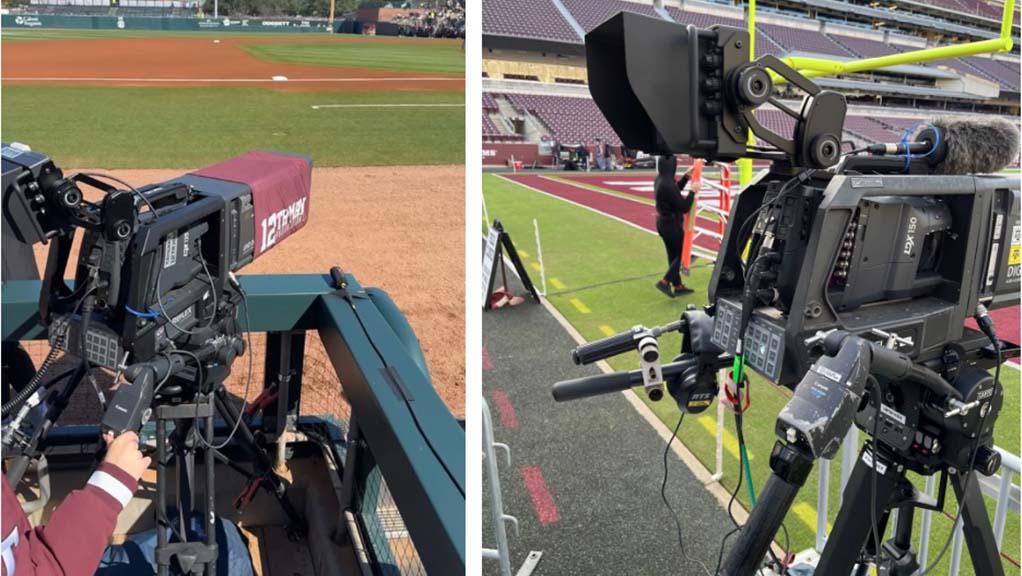Texas A&M Athletics Ups Its Game With Cameras From Grass Valley
SEC member’s busy in-house production team looks for 1080p resolution, signal-routing flexibility

COLLEGE STATION, Texas—At Texas A&M, we’ve always looked for ways to improve how we cover our athletic events. Between our in-house team at 12th Man Productions and the work we do with ESPN and the SEC Network, we’re producing more live events than ever—and the demands keep growing. So last year, when we decided to upgrade our camera systems, we knew it had to be a leap forward and not just a small step. That’s what led us to Grass Valley’s LDX 100 series.
We ended up going with 10 LDX 135s and four LDX 150s. These cameras are doing a lot of heavy lifting for us across multiple venues on campus. What really sold us was the fact that they’re native IP (2110), which let us rethink how we manage camera signals. The ability to run these cameras without needing a camera control unit (CCU) allowed us to connect them to our 2110 network leaf switches at each venue rather than running direct fiber all the way back to our central control room. That freed up a ton of fiber and gave us way more flexibility in how we route and manage signals.
New Workflows
The move to 1080p was long overdue and this upgrade was the last step in that process. Now, we’re setting our sights on what’s next. The image quality we have seen on these cameras has us seriously exploring 1080p HDR workflows. While we’re not there yet, it’s a direction we’re actively evaluating, and early internal tests have shown a lot of promise.
Adding the four LDX 150s to our camera complement has been a massive boost to high-frame-rate looks at all of our sports. Moving from two to four high-speed, six-phase cameras has given us the flexibility to no longer have to decide which sport or event will get the high-frame-rate cameras. Now we can spread them out to give us the incredible high-speed look the LDX150s offer at all of our biggest events, especially when we have multiple events going on at the same time.
What’s also been huge—especially for our students who are learning the craft—is the Creative Grading tool. The cameras give them a lot of latitude to adjust looks based on the sport or lighting and the tool gives them a really good understanding of color grading and how it all works. It’s made our content feel more polished and intentional.
Remote Camera Control
From an engineering perspective, I also appreciate how easy it is to monitor everything remotely. With venues spread across campus, being able to check in on a camera or tweak a setting from my desk—or even off-site—has saved me a lot of time and, honestly, a lot of stress.
We’ve been working with Grass Valley for a while now, and that history gave us a lot of confidence going into this. Their gear has always been reliable and this latest rollout has only reinforced that. Working with Diversified on the integration side made a huge difference, too. They know us, they know Grass Valley and they understood what we were trying to build. It wasn’t just about new cameras—it was about designing a system that could scale as our needs evolve.
The professional video industry's #1 source for news, trends and product and tech information. Sign up below.
Right now, we’re producing more high-quality content than ever, with more flexibility and fewer limitations. We’ve created a smarter, more-efficient workflow that’s not only better for our crew and students but also sets us up for whatever comes next—whether that’s HDR, UHD or whatever else the industry throws our way.
And we’re just getting started.
For more information, visit www.grassvalley.com.

Jonathan Kerr is the chief broadcast engineer at Texas A&M University, where he leads technical operations for 12th Man Productions and oversees all live event production infrastructure for Aggie Athletics. He can be reached at jkerr@athletics.tamu.edu.
